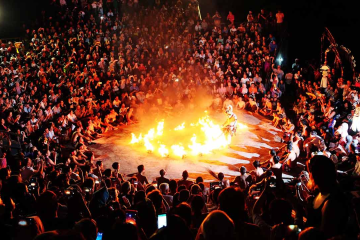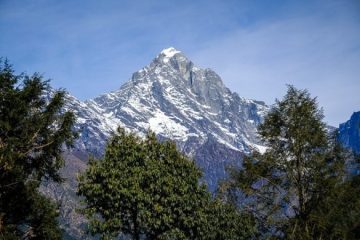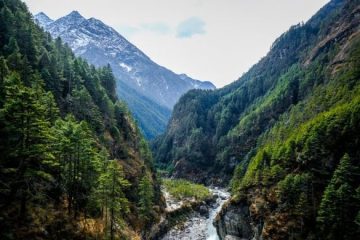This former caldera complex has everything from active volcanoes to ancient Hindu temples, smoking sulfuric springs, multicolored lakes, fresh mountain air, sunrise views, and endless terraces covering the hills in every direction.
Me and a buddy spent a full day exploring Dieng last summer, and we were blown away by this hidden gem and how few international tourists seem to know about it. The Dieng Plateau sunrise is especially good.
Dieng means ‘Abode of the Gods,’ and that name seems about right for the incredible scale and mystery of this place! This travel blog will explain how you can get to Dieng Plateau, and everything you need to know before you go!


Where Is Dieng Plateau?
Dieng Plateau is located 115 kilometers (70 miles) west of Yogyakarta city in central Java, Indonesia.
The nearest airport is also in Yogyakarta (YIA), and it’s served by a bunch of budget friendly airlines with good ratings. You can shop for flights to Yogyakarta at Skyscanner.
Despite the short distance, the drive from Yogya to Dieng Plateu takes much longer than you would expect — about 4 hours — because of the winding mountain roads. I don’t think I’ve ever come so close to throwing up in a car.
Still, don’t let the long drive put you off from coming here, because Dieng Plateau was honestly one of the coolest highlights of our time in Java!

How To Get There
The easiest and best way to visit Dieng Plateau is with a shared tour or a private driver from Yogyakarta for the full day.
If you want to do this with a vetted tour company, GetYourGuide has high rated day tours to Dieng Plateau from Yogyakarta.
The tours include hotel pickup and drop-off, all entrance fees, and an English speaking tour guide. We’ve used GetYourGuide for lots of tours and activities around the world, and they’re great. Highly recommended!
Another option is to hire a local driver from Yogya yourself and negotiate the terms directly, and that way you can try to add some extra sights if you have any in mind.
It’s almost 8 hours of roundtrip driving, and we spent another 5 hours exploring the sights!
Dieng Plateau: What To Expect
Sunrise on the volcano is one of the highlights of a trip to Dieng Plateau, but unfortunately the 4 hour drive from Yogyakarta means you’ll need a very early start.
Our driver picked us up at 11:00 PM (yes you read that right), but this was overkill. We arrived at Sikunir hill with time to spare and ended up sleeping in the van for something like 2 hours.
Do take a big nap on the day before, and ask your driver for the latest start possible!

Dieng Plateau Java
What To Bring
- Jacket: It’s chilly, so definitely bring a jacket or hoodie. You can shed it after sunrise. This is a higher elevation than most of Indonesia, so temps before sunrise can be as low as 8 C (47 F).
- Long Pants: See above. Pants are a good idea to stay warm.
- Hiking Shoes: The sunrise hike is not sandal friendly, and may be muddy. Wear shoes.
- Flashlight: You’ll want a flashlight (or your phone will work) for hiking in the dark before sunrise.
- Camera: Duh! You will definitely want a camera and drone to capture the scenery of this place.


Things To Do & See At Dieng Plateau
• Sikunir Sunrise
One of the main attractions of Dieng Plateau is watching the sunrise over Mount Sundoro, one of Java’s active volcanoes.
The popular spot to do this is on Sikunir Hill, at the eastern edge of the plateau. Your driver can help you find the trailhead, and the path itself is pretty easy to follow. From the car park, it’s a steep but short hike to the top of the hill, and only takes about 30-45 minutes.
Keep going until you reach the highest point for photos. If the sunrise in Dieng Plateu is at 5:20 AM, then you want to be at the top of the hill no later than 5:00, or maybe even 4:45 so you can find a good spot for taking photos.
At the top, we hunkered down with a bunch of friendly Indonesian locals who wanted to take selfies with us since they rarely see bule-bule (westerners) here. The sunrise was foggy, but beautiful.

• Telaga Warna Lake
This is a pair of sulfuric lakes that turn weird shades of green and yellow.
You can view the lakes from above for 30k Rupiah, or pay 100k to walk down to the bottom. When we went, there was no one at the ticket booth so we got to see the upper lakes for free.
My advice: skip the lower viewpoint, it’s overpriced and the best views are above the lakes anyway.

• Hill Terraces
Dieng Plateau is loaded with terraces of potatoes, strawberries, and other crops.
You can hike around to some of these hills if you have extra time, but the roads and hills at Dieng are not very pedestrian friendly.
The very best way to see the terraces is by drone. This place is drone heaven.

• Sikidang Crater
This is a big smoking sulfur crater accompanied by lots of smaller bubbling geothermal pots.
You can expect the usual stinking sulfur smell, and there are also a bunch of tacky ornaments and gaudy selfie spots (including a big stuffed gorilla) that kind of cheapen the experience and make it even weirder.

• Arjuna Temple
Dieng Plateu has a bunch of 7th century temples that are actually some of the oldest surviving buildings on the island of Java.
Arjuna Temple is in the best condition, and entry is included for free as part of the ticket you already bought for Sikidang Crater.

Entrance Fees
- Sikunir Hill: Free
- Telaga Warna Lake (Upper): 30k IDR
- Telaga Warna Lake (Lower): 100k IDR
- Sikidang Crater + Arjuna Temple: 30k IDR


Hotels Near Dieng Plateau
If you feel like staying longer in the area, there are a bunch of homestay options in Dieng Plateau and the nearby city of Wonosobo.
We decided to base ourselves in Yogyakarta instead, and visit Dieng on a day trip. There are lots of great hotels, restaurants, and malls in Yogya with very affordable prices!
Where We Stayed
We stayed at stepHouse Homestay in Yogyakarta. It was $17 USD per night for a clean twin room with A/C, private bathroom, and fast WiFi.
One of the biggest positives of this homestay is the location. It was walking distance to the Malioboro mall and train station, which is perfect if you’re planning to take the train to Malang to visit Tumpak Sewu and Mount Bromo like we were!
Prices may fluctuate from time to time, so just keep an eye out for a good deal.
Is Java Safe?
I’d say definitely yes, Java is safe, and I’ve visited the island many times over the years.
Indonesia has one of the lowest violent crime rates in the world. We walked around Yogyakarta at all hours of the day and night, and always felt safe.
Nowhere in the world is perfectly safe, but Indonesia gets millions of tourists every year, and many of them visit Java.

Best Time To Visit
The best time to visit Java (and most parts of Indonesia) is from April to November.
The rainy season runs from November to April. You can still go to Dieng Plateau during this time, but it won’t be ideal for the mountains or sunrise because fog is more common.
Happy travels!


See Also
- 1-Week East Java Itinerary – Temples, Waterfalls, & Volcanoes
- Mount Bromo Volcano Sunrise – Complete Travel Guide
- Kawah Ijen Crater Lake – Complete Travel Guide
- Best Hikes In Indonesia – Volcanoes, Jungles, & Waterfalls
- Most Beautiful Indonesian Islands – Best Places To Visit In Indonesia
- Indonesia Waterfall Guide – Best Waterfalls In Indonesia
- Indonesia Beach Guide – Best Beaches In Indonesia
- Best Things To Do In Indonesia – What To Do In The Islands
- Indonesia Travel Guide – Tips, Info, & Photos





0 Comments